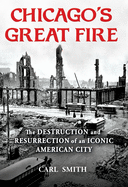
In October 1871, fire swept through Chicago, destroying much of the 40-year-old city in a few days and leaving 90,000 people homeless. In Chicago's Great Fire: The Destruction and Resurrection of an Iconic American City, urban historian Carl Smith (City Water, City Life) tells the story of the fire and Chicago's astonishing recovery, as well as how the disaster has played into Chicago's self-image over the 150 years since it occurred.
Smith's description of the fire's race through the city is gripping. Though readers already know how the story ends, he creates narrative tension through a series of vignettes based on the memories of those who fled the fire--including the long-maligned Mrs. O'Leary. (Spoiler alert: Smith demonstrates convincingly that neither O'Leary nor her cow were responsible for the disaster.)
His discussion of why Chicago was vulnerable to fire and how it rebounded so quickly are equally fascinating. The city was growing rapidly, but the local government was unwilling to listen to warnings about the potential danger of fire. Smith explores the city's divisive class, religious and ethnic differences, the struggles for political control resulting from those differences, and the outpouring of international support after the fire. He also considers innovations that affected the response to the fire, including the creation of professional fire departments and the rise of a popular press.
Chicago's Great Fire is a colorful and careful account of the growth and regrowth of an American city. --Pamela Toler, blogging at History in the Margins

